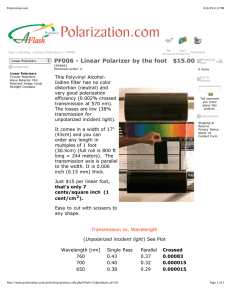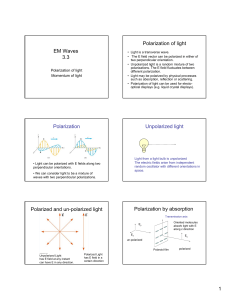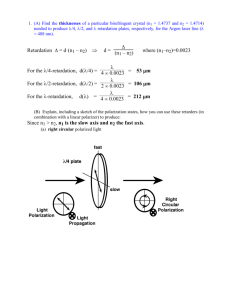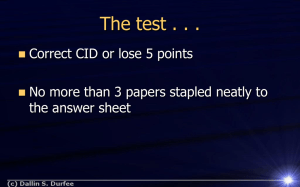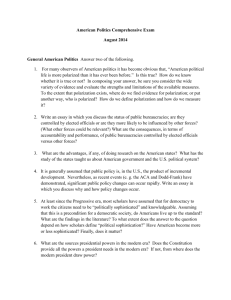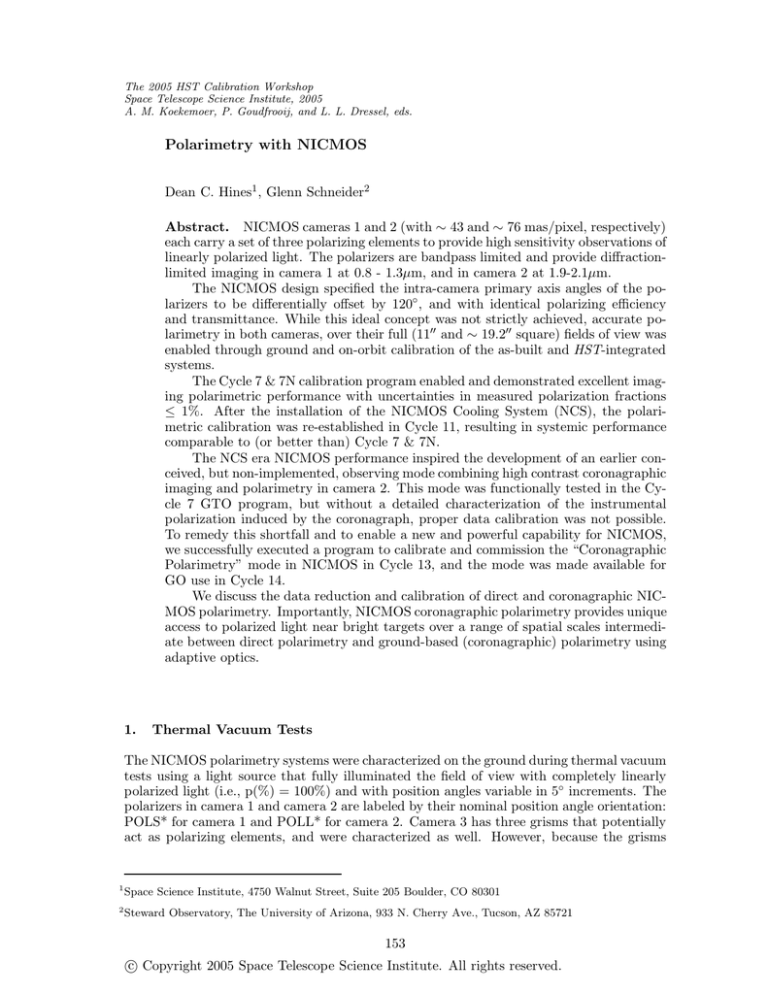
The 2005 HST Calibration Workshop
Space Telescope Science Institute, 2005
A. M. Koekemoer, P. Goudfrooij, and L. L. Dressel, eds.
Polarimetry with NICMOS
Dean C. Hines1 , Glenn Schneider2
Abstract. NICMOS cameras 1 and 2 (with ∼ 43 and ∼ 76 mas/pixel, respectively)
each carry a set of three polarizing elements to provide high sensitivity observations of
linearly polarized light. The polarizers are bandpass limited and provide diffractionlimited imaging in camera 1 at 0.8 - 1.3µm, and in camera 2 at 1.9-2.1µm.
The NICMOS design specified the intra-camera primary axis angles of the polarizers to be differentially offset by 120◦ , and with identical polarizing efficiency
and transmittance. While this ideal concept was not strictly achieved, accurate polarimetry in both cameras, over their full (1100 and ∼ 19.200 square) fields of view was
enabled through ground and on-orbit calibration of the as-built and HST-integrated
systems.
The Cycle 7 & 7N calibration program enabled and demonstrated excellent imaging polarimetric performance with uncertainties in measured polarization fractions
≤ 1%. After the installation of the NICMOS Cooling System (NCS), the polarimetric calibration was re-established in Cycle 11, resulting in systemic performance
comparable to (or better than) Cycle 7 & 7N.
The NCS era NICMOS performance inspired the development of an earlier conceived, but non-implemented, observing mode combining high contrast coronagraphic
imaging and polarimetry in camera 2. This mode was functionally tested in the Cycle 7 GTO program, but without a detailed characterization of the instrumental
polarization induced by the coronagraph, proper data calibration was not possible.
To remedy this shortfall and to enable a new and powerful capability for NICMOS,
we successfully executed a program to calibrate and commission the “Coronagraphic
Polarimetry” mode in NICMOS in Cycle 13, and the mode was made available for
GO use in Cycle 14.
We discuss the data reduction and calibration of direct and coronagraphic NICMOS polarimetry. Importantly, NICMOS coronagraphic polarimetry provides unique
access to polarized light near bright targets over a range of spatial scales intermediate between direct polarimetry and ground-based (coronagraphic) polarimetry using
adaptive optics.
1.
Thermal Vacuum Tests
The NICMOS polarimetry systems were characterized on the ground during thermal vacuum
tests using a light source that fully illuminated the field of view with completely linearly
polarized light (i.e., p(%) = 100%) and with position angles variable in 5◦ increments. The
polarizers in camera 1 and camera 2 are labeled by their nominal position angle orientation:
POLS* for camera 1 and POLL* for camera 2. Camera 3 has three grisms that potentially
act as polarizing elements, and were characterized as well. However, because the grisms
1
Space Science Institute, 4750 Walnut Street, Suite 205 Boulder, CO 80301
2
Steward Observatory, The University of Arizona, 933 N. Cherry Ave., Tucson, AZ 85721
153
c Copyright 2005 Space Telescope Science Institute. All rights reserved.
154
Hines & Schneider
reside in the NIC3 filter wheel, they cannot be used with either the NIC1 or NIC2 polarizers
and are unsuitable for spectropolarimetry.
The primary results of these thermal vacuum tests include:
• Each polarizer in each camera has a unique polarizing efficiency1 , with POL120S
having the lowest at POL120S = 48%.
• The angular offsets between the polarizers within each filter wheel differ from their
nominal values of 120◦ .
• The instrumental polarization caused by reflections off the mirrors and optical baffles
in the optical train is small (≤ 1%).
• The grisms indeed act as partial linear polarizers, with the long wavelength grism
(G206) producing the largest variation in intensity (∼5%) for 100% linearly polarized
light. If one measures the equivalent width of an emission line against a polarized
continuum, the measurement will have different values depending on the orientation
of the spacecraft w.r.t. the position angle of the polarized continuum. This effect
scales with the source polarization, so should not be important for objects of low
polarization (p(%) ≤ 10%).
2.
The Algorithm for Reducing NICMOS Polarimetry Observations
The thermal vacuum results showed that the standard reduction algorithm listed in basic
optics text books would not work for NICMOS data. Instead, a more general approach
was required (Hines, Schmidt & Lytle 1997; Hines 1998; Hines, Schmidt & Schneider 2000;
Hines 2002).
At any pixel in an image, the observed signal from a polarized source of total intensity
I and linear Stokes parameters Q and U measured through the kth polarizer oriented at
position angle ϕk is
Sk = Ak I + k (Bk Q + Ck U ) .
(1)
Here,
tk
(1 + lk ), Bk = Ak cos 2ϕk , Ck = Ak sin 2ϕk ,
(2)
2
k is the polarizing efficiency, tk is the fraction of light transmitted through the polarizer for
a 100% linearly polarized input aligned with the polarizer axis, and lk is the “leak” – the
fraction of light transmitted through the polarizer (exclusive of that involved in tk ) when
the incident beam is polarized perpendicular to the axis of the polarizer. These quantities
are related under the above definitions, k = (1 − lk )/(1 + lk ).
This treatment can be shown to be equivalent to other approaches, once appropriate
transformations are made (Mazzuca, Sparks, & Axon 1998; see also Sparks & Axon 1999).
The values of tk were determined initially by the filter manufacturer from witness samples, and were not accurately remeasured during thermal vacuum tests. However, on-orbit
observations of the unpolarized and polarized standard stars enables refinement of these
numbers. Adopted characteristics of the individual polarizers and algorithm coefficients
derived during and applicable to Cycle 7 & 7N are listed in Table 1 of Hines, Schmidt &
Schneider (2000), the Cycle 11 coefficients are listed in Hines (2002), and are also available
Ak =
1
Polarizing efficiency is defined as = (Spar − Sperp )/(Spar + Sperp ), where Spar and Sperp are the respective
measured signals for a polarizer oriented parallel and perpendicular to the position angle of a fully polarized
beam.
Polarimetry with NICMOS
155
in the NICMOS instrument manual and the HST Data Handbook. The primary coefficients
are also listed in Table 1 in this contribution.
After solving the system of equations (eq. 1) for the Stokes parameters at each pixel
(I, Q, U ), the percentage polarization (p) and position angle (θ) are calculated in the standard way:
p
1
U
Q2 + U 2
.
(3)
p = 100% ×
, θ = tan−1
I
2
Q
Note that a 360◦ arctangent function is assumed.
This algorithm has been tested by the NICMOS Instrument Definition Team (IDT) and
by the Space Telescope Science Institute (STScI) on several data sets. An implementation
has been developed by the IDT, and integrated into a software package written in IDL.
The package is available through the STScI website2 and is described by Mazzuca & Hines
(1999). An update with improved graphical user interface will be available for Cycle 15.
3.
The Cycles 7, 7N & 11 Polarimetry Characterization Programs
Observations of a polarized star (CHA-DC-F7: Whittet et al. 1992) and an unpolarized
(null) standard (BD + 32 3739: Schmidt, Elston & Lupie 1992) were obtained with NIC1
and NIC2 in Cycle 7 & 7N (CAL 7692, 7958: Axon PI) and in Cycle 11 (CAL 9644: Hines
PI). Data were obtained at two epochs such that the differential telescope roll between
observations was ≈ 135◦ . This removes the degeneracy in position angle caused by the
pseudo-vector nature of polarization. The second epoch observations in Cycle 7N and all
of the observations in Cycle 11 used a four position, spiral-dither pattern with 20.5 pixel
(NIC1) and 30.5 pixel (NIC2) offsets to improve sampling and alleviate the effects of bad
pixels, some persistence, and other image artifacts. This is also the recommended observing
strategy for all NICMOS, direct imaging polarimetry programs. While no dither pattern
was used during the first epoch of Cycle 7, the data do not appear to suffer significantly
from persistence. Observations of the highly polarized, proto-planetary nebula CRL 2688
(Egg Nebula) were also obtained to test the calibration over a large fraction of the field of
view.
The observations were processed through the CALNICA pipeline at STScI using the
currently available reference files. Aperture photometry was used to measure the total flux
density from the stars in instrument units (DN/s) for each polarizer. The Stokes parameters
were then constructed using equation (1). Since the thermal vacuum tests showed that
the imaging optics themselves have little effect on the observed polarization, any measured
polarization in the null standard was attributed the tk term in the algorithm. The algorithm
was applied to the polarized standard stars to check both the percentage polarization and
the position angles.
The higher, yet more stable, operating temperature provided by the NCS and the
three year dormancy of NICMOS may contribute to changes in the metrology of the optical
system. Therefore, a program to re-characterize the polarimetry optics in Cycle 11 has been
developed (NIC/CAL 9644: Hines).
The basic design of the Cycle 11 program follows the strategy undertaken in Cycle 7
& 7N, relying on observations of polarized and unpolarized standard stars as well as the
proto-planetary nebula CRL 2688 (Egg Nebula). The Egg Nebula was only observed at a
single epoch as a direct comparison with observations from Cycle 7 & 7N (ERO 7115: Hines;
Sahai et al. 1998; Hines, Schmidt & Schneider 2000), and to evaluate any gross discrepancies
across the field of view. Observations of the unpolarized standard star (p(%)intrinsic = 0%,
by definition) processed with the Cycle 7 & 7N algorithm coefficients yield pNIC1 = 0.7% ±
2
http://www.stsci.edu/hst/nicmos/tools/polarize tools.html
156
Hines & Schneider
0.2%, θNIC1 = 74◦ and pNIC2 = 0.7% ± 0.3%, θNIC2 = 73◦ . This suggests that the system
changed. The observations of the polarized standard star is also larger (∆p ≈ 2%) in NIC1
compared with the measurements of Cycle 7 & 7N, which themselves were in excellent
agreement with ground-based measurements (Hines, Schmidt & Schneider 2000).
Observations of the Egg Nebula were also analyzed with the Cycle 7 & 7N coefficients. As for the polarized standard star, the results for the Egg Nebula suggest that the
polarimetry system has changed slightly3 , again by about 2% in p%.
We rederived the coefficients assuming that any measured polarization in the unpolarized (Q=U=0) standard was attributed to the tk term in the algorithm (i.e. the variable
term in the Ak coefficient). The new coefficients are listed in Table 1.
We note that we are embarking on a new study of all of the NICMOS direct imaging
polarimetry calibration data in an attempt to improve the calibration to better than 0.3%
(Batcheldor et al. 2006). This study was prompted by reports of a ∼ 1.5% systematic
residual polarization signal in some objects (e.g., Ueta et al. 2005). Indeed, Batcheldor
et al. find a residual excess polarization for the ensemble of (un)polarized standard stars
of p(%) ≈ 1.2%, which behaves as a constant “instrumental” polarization that can be
subtracted (in Stokes parameters) from the observations. While insignificant for highly
polarized objects, this residual will affect observations of low polarization objects such as
active galactic nuclei.
Due to the non-ideal polarimetry optical system, estimation of the uncertainties in the
percentage polarization require a slightly more sophisticated analysis, especially for NIC 1.
Monte Carlo simulations of the uncertainties based on the NICMOS performance are given
in Hines, Schmidt & Schneider (2000), and an analytical approach is given in Sparks &
Axon (1999). In particular, the usual assumption that σq = σu is not valid for NIC 1.
4.
Coronagraphic Polarimetry with NICMOS
Coronagraphic polarimetric observations of the same unpolarized and polarized standard
stars that were used in Cycle 7, 7N (CAL 7692, 7958: Axon PI) and Cycle 11 (CAL 9644:
Hines PI), and observations of the face-on circumstellar disk TW Hya were each obtained
at two epochs sufficiently spaced in time to permit large differential rolls of the spacecraft
(i.e., field orientations w.r.t. the HST optics and NICMOS polarizers). At each epoch,
coronagraphic polarimetric imaging was carried out at two field orientations differing by
29.9◦ . Following standard NICMOS Mode-2 target acquisitions, the acquired targets were
observed through each of the three “Long” wavelength polarizers in Camera 2. The intravisit repeats for the standard stars were designed to check both for repeatability (image
stability) and possible image persistence (none of consequence were found). TW Hya was
exposed in only two repeats for each polarizer.
To facilitate commonality in data processing, all coronagraphic imaging was done with
STEP16 multiaccum sampling, though the number of samples varied between 10 to 12
to best fill the orbits for each of the targets. The data were instrumentally calibrated in
an APL-based analog to the STSDAS CALNICA task using on-orbit derived calibration
reference files suitable for these observations. Following the creation of count rate images,
individual bad pixels were replaced by 2D weighted Gaussian interpolation (r=5 weighing
radius) of good neighbors, and “horizontal striping” associated with heavily exposed targets
was characterized and removed by median-collapse subtraction.
3
The polarization structure of the Egg is not expected to change over the 5 year period between observations
even though the object is known to show photometric variations.
Polarimetry with NICMOS
4.1.
157
PSF-subtracted Images
The image data for this program were obtained to investigate and demonstrate the further
suppression of instrumentally scattered light via the camera 2 coronagraph (compared to
non-coronagrahic polarimetry) and thus effect a reduction in the detection floor for a polarized signal in the diffuse wings of the (suppressed) scattering component of the occulted
PSF core. For this purpose, the data obtained were not optimized to enable coronagraphic
PSF subtraction (see, e.g., Fraquelli et al. 2004). Imaging coronagraphy under the pass
band Camera 2 1.9-1.2µm polarizers will be less effective than under the 1.4-1.8µm F160W
(H band) filter. Imaging coronagraphy of our calibration science target, the very-near faceon TW Hya circumstellar disk under the F160W filter was discussed in Weinberger et al.
(2002). The smaller inner working angle of the coronagraph with polarizers (caused by
the longer wavelength pass-band), while fully enclosing the PSF core under the polarizers,
permits light from the first Airy ring to escape the coronagraphic image plane mask.
Both the unpolarized standard BD +32 -3739 and the polarized standard CHA-DC-F7
were selected to establish “truth” w.r.t. the instrumental polarization (and ultimately sensitivity) with polarimetric coronagraphy. They were not chosen to serve as coronagraphic
reference PSF’s for subtraction from TW Hya, and both calibration stars are significantly
fainter than TW Hya. Additionally, the field of the unpolarized standard has a significant number of fainter stars near the target, unknown prior to the coronagraphic imaging
resulting from this program. This is not a problem for the coronagraphic polarimetric calibration/validation, but as such that additionally makes it a poor choice as a PSF subtraction
template star.
Nonetheless, DIRECT imaging of circumstellar dust from the Camera 2 polarizer set
derived total intensity images is demonstrated (but not comprehensively in this summary)
using this “template” PSF. The depth of exposure of BD+32 is insufficient to reveal the
outer part of the TW Hya disk. The flux density rescaling of BD+32 is suggested as 3.48
from the 2MASS H and K magnitudes and the passband of the Camera 2 polarizers. The
disk persists varying the DB+32 intensity over the full range of TW Hya:BD+32 intensities
suggested in H and K, though very significant under- and over-subtraction residuals appear
at the extreme of that range in the diffraction spikes, suggesting the a priori ratio was very
close to “correct”.
4.2.
Polarimetry Comparison Between the Unpolarized Star and TW Hya
After reduction of the images in the three different polarizers, the images were processed
through the NICMOS polarimetry reduction algorithm (Hines, Schmidt & Schneider 2000)
to produce images of the polarization position angle (θ), the percentage polarization, and
the polarized intensity (= p × I). To consider the detection of polarized flux to be “well
determined” we demand the polarized intensity in any pixel be at least 5-sigma above the
median of the background. For this data set we choose a background region far from the
target, and away from the diffraction spikes, where no contribution to the background from
the target flux is seen. With this, the centrosymmetric polarization field for the near-face
on TW Hya disk is obvious, and highly repeatable, in all four field orientations of the TW
Hya observations.
While some residual instrumental polarization seems apparent, the lack of obvious
structure in the position angle image of the unpolarized standard star is dramatically different than that of the TW Hya position angle image; the TW Hya image shows the classic
“butterfly” pattern for centrosymmetric polarization cased by scattering off a face-on disk.
Furthermore, the median polarization is about 2% per resolution element for the “unpolarized” star, compared with ∼ 10 − 15% per resolution element for TW Hya. The results for
TW Hya are shown in Figure 1. The measured polarization in the disk is consistent with
measurements made from the ground with Adaptive Optical systems (D. Potter, private
comm., and Hales et al. 2005).
158
Hines & Schneider
4.3.
Continued Analysis
Our analysis so far has shown that the mode is viable for future Cycles. We have sufficient
data in hand to evaluate:
• The ability to remove the small instrumental polarization signature in Stokes parameter space.
• The spatial correlation of this instrumental polarization as a function of radius and
azmuth with respect to the coronagraphic hole.
• The polarization sensitivity as a function of radius from the coronagraphic hole. This
analysis is limited by the exposure depth of the unpolarized standard.
4.4.
Recommendations
Based upon our preliminary analysis, we recommend that NICMOS coronagraphic polarimetry be released as an available mode for future Cycles. We note that the same rules that
apply to direct coronagraphic imaging apply to this mode as well. In particular, the fine
guidance necessary to keep the target well centered in the hole is necessary. In addition, we
recommend that observations be obtained at two-roll angles to interpolate over bad pixels
and develop an in situ flat field correction near the coronagraphic hole. This may be difficult
to achieve in two-gyro mode.
We cannot yet tell if the current calibration data from Cycle 12 will be sufficient for
GOs. At present, we would urge that GOs observe their target plus an unpolarized standard
star, each at sufficient depth to obtain similar S/N in each object in each polarizer thus
a minimum of two orbits for a single target program. However, a single, well exposed
unpolarized standard star should be sufficient for a multi-target science program.
5.
Two-Gyro Mode
Based upon the measured jitter in two-gyro mode, there should be no degradation of the
direct polarimetry mode. Tests of coronagraphic imaging also suggest minimal degradation
(Schneider et al. 2005, ISR2005-001). The primary impact will be the inability to obtain
images at two spacecraft roll angles within a single orbit.
6.
Summary
A wide variety of astronomical objects have been examined with NICMOS direct imaging
polarimetry including Active Galaxies (Capetti et al. 2000; Tadhunter et al. 2000; Simpson
et al. 2002), evolved stars and proto-planetary nebulae (Sahai et al. 1998; Weintraub et
al. 2000; Schmidt, Hines & Swift 2002; King et al. 2002; Su et al. 2003; Ueta et al. 2005),
and young stellar objects (Silber et al. 2000; Meakin, Hines & Thompson 2005). NICMOS
continues to provide high fidelity, high spatial resolution imaging polarimetry. Combined
with the polarimetry mode of the Advanced Camera for Surveys (ACS), HST provides
high resolution imaging polarimetry from ∼ 0.2 − 2.1µm. With the newly commissioned
coronagraphic polarimetry mode, NICMOS provides further unique access to polarized light
near bright targets over a range of spatial scales intermediate between direct polarimetry
and ground-based (coronagraphic) polarimetry using adaptive optics.
An electronic version of the presentation given by D.C. Hines at the workshop can be
found at the following URL:
http://www.stsci.edu/ts/webcasting/ppt/CalWorkshop2005/DeanHines102805.ppt
Polarimetry with NICMOS
159
References
Capetti, A., et al. 2000, ApJ, 544, 269
Fraquelli, D. A., Schultz, A. B., Bushouse, H., Hart, H. M., & Vener, P. 2004, PASP, 116,
55
Hales, A. S., Gledhill, T. M., Barlow, M. J., & Lowe, K. T. E. 2005, ArXiv Astrophysics
e-prints, arXiv:astro-ph/0511793
Hines, D. C., 2003, in Proc. 2002 HST Calibration Workshop, ed. S. Arribas, A. Koekemoer,
& B. Whitmore (Baltimore: STScI), p. 260
Hines, D.C., Schmdit, G.D. & Schneider, G. 2000, PASP, 112, 983
Hines, D. C. 1998, NICMOS and the VLT: A New Era of High Resolution Near Infrared
Imaging and Spectroscopy, Pula, Sardinia, Italy, June 26-27th 1998 ESO Conference
and Workshop Proceedings 55, 1998, Wolfram Freudling and Richard Hook eds.,
p. 63, 63
Hines, D. C., Schmidt, G. D., & Lytle, D. 1997, The 1997 HST Calibration Workshop with
a New Generation of Instruments, p. 217, 217
King, N. L., Nota, A., Walsh, J. R., Panagia, N., Gull, T. R., Pasquali, A., Clampin, M.,
& Bergeron, L. E. 2002, ApJ, 581, 285
Mazzuca, L., Sparks, B., & Axon, D. 1998, Instrument Science Report NICMOS 98-017
(Baltimore: STScI), available through http://www.stsci.edu/hst/nicmos
Mazzuca, L. & Hines, D.C. 1999, Instrument Science Report NICMOS 99-004 (Baltimore:
STScI)
Meakin, C. A., Hines, D. C., & Thompson, R. I. 2005, ApJ, 634, 1146
Sahai, R., Hines, D. C., Kastner, J. H., Weintraub, D. A., Trauger, J. T., Rieke, M. J.,
Thompson, R. I., & Schneider, G. 1998, ApJ, 492, L163
Schmidt, G. D., Elston, R., & Lupie, O. L. 1992, AJ, 104, 1563
Schmidt, G. D., Hines, D. C., & Swift, S. 2002, ApJ, 576, 429
Silber, J., Gledhill, T., Duchêne, G., & Ménard, F. 2000, ApJ, 536, L89
Simpson, J. P., Colgan, S. W. J., Erickson, E. F., Hines, D. C., Schultz, A. S. B., &
Trammell, S. R. 2002, ApJ, 574, 95
Sparks, W.B., & Axon, D.J. 1999, PASP, 111, 1298
Su, K. Y. L., Hrivnak, B. J., Kwok, S., & Sahai, R. 2003, AJ, 126, 848
Ueta, T., Murakawa, K., & Meixner, M. 2005, AJ, 129, 1625
Tadhunter, C. N., et al. 2000, MNRAS, 313, L52
Thompson, R. I., Rieke, M., Schneider, G., Hines, D. C., & Corbin, M. R. 1998, ApJ, 492,
L95
Weinberger, A. J., Becklin, E. E., Schneider, G., Chaing, E. I., Lowrance, P. J., Silverstone,
M., Zuckerman, B., Hines, D. C. & Smith, B. A., 2002, ApJ, 566, 409
Weintraub, D. A., Kastner, J. H., Hines, D. C., & Sahai, R. 2000, ApJ, 531, 401
160
Hines & Schneider
Radius (Arcsec)
0.5
1
1.5
2
2.5
3
25
Polarization (%)
20
15
10
5
Intensity (Arbitraty Units)
0
V30_I
V30_P*I
V31_I
V31_P*I
V60_I
V60_P*I
V61_I
V61_P*I
I_median
P*I_median
Total Intensity (I)
10
1
Polarized Intensity (P*I)
0.1
5
10
15
20
25
30
35
40
Radius (Pixels)
Figure 1: Coronagraphic polarimetry of TW Hya. The top panel shows the percentage
polarization. The bottom panel shows the azimuthally averaged total intensity and the
polarized intensity.
161
Polarimetry with NICMOS
Table 1.
Characteristics of the NICMOS Polarizers & Coefficients to Eq. (1)
Filter
ϕk
k
tk (Pre-NCS)a
tk (NCS)a
Comments
POL0S
POL120S
POL240S
1.42
116.30
258.72
0.9717
0.4771
0.7682
0.7760
0.5946
0.7169
0.7760
0.5934
0.7173
Ghosts
Weak ghosts
Ghosts
POL0L
POL120L
POL240L
8.84
131.42
248.18
0.7313
0.6288
0.8738
0.8981
0.8551
0.9667
0.8779
0.8379
0.9667
...
...
...
a Derived
from on-orbit observations of the unpolarized standard star
BD+32◦ 3739 (Schmidt, Elston & Lupie 1992).


